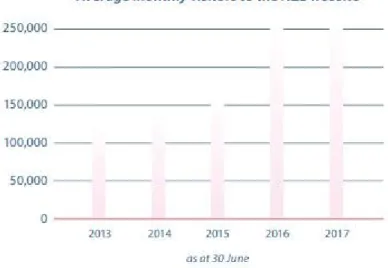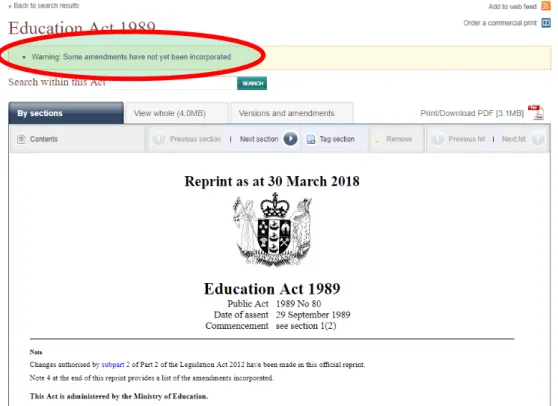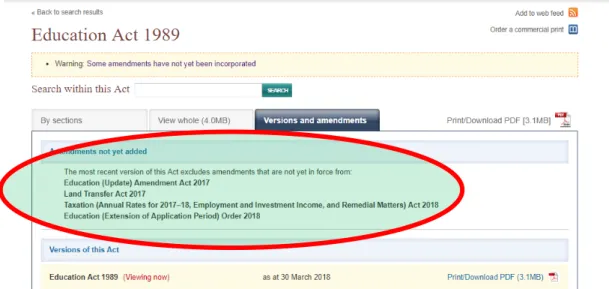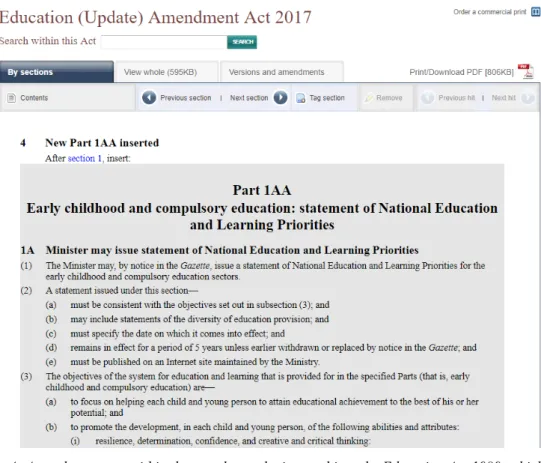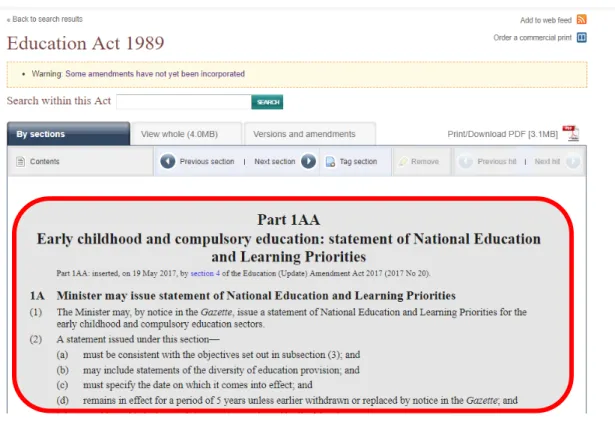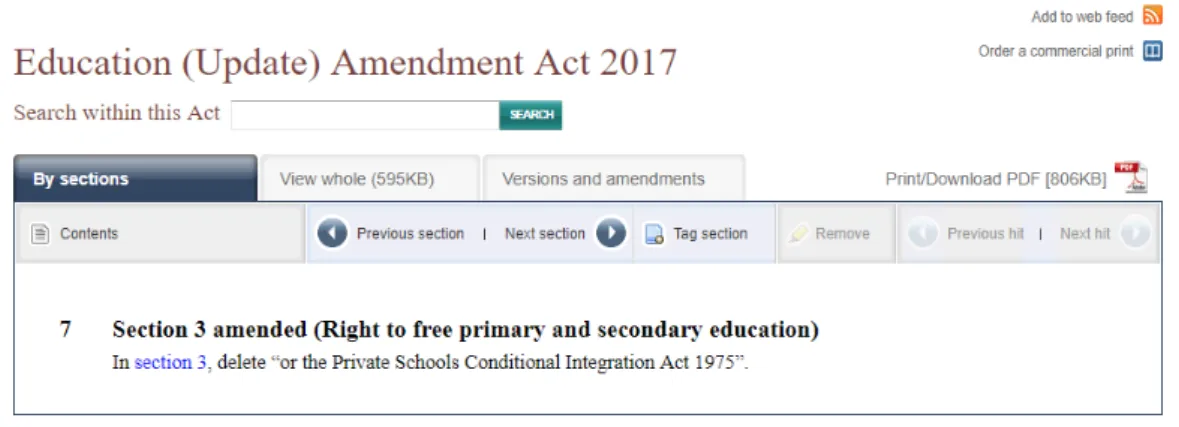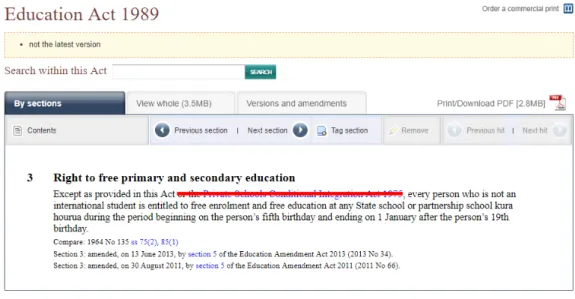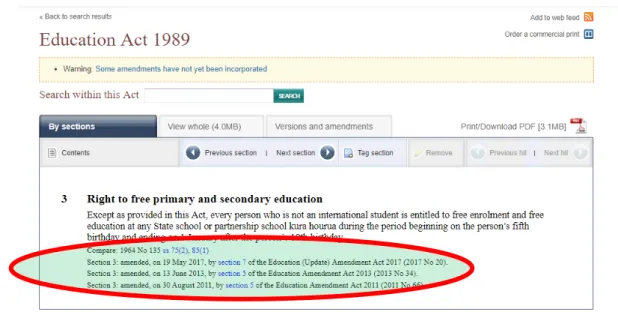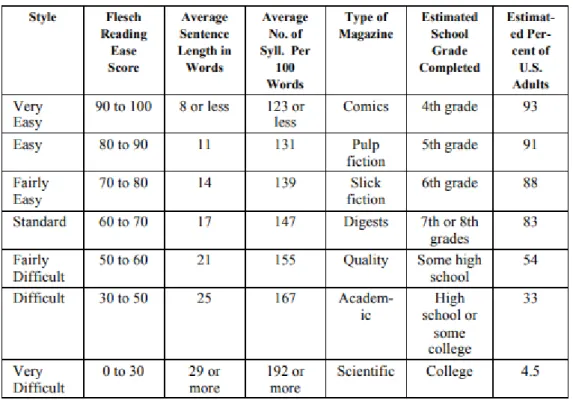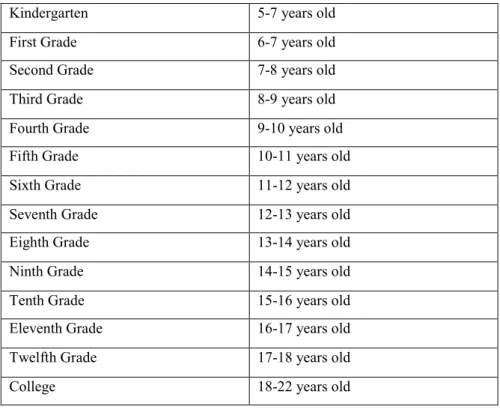EMILY CHAN
ENHANCING ACCESSIBILITY: AN OBJECTIVE ASSESSMENT OF THE AVAILABILITY,
NAVIGABILITY AND UNDERSTANDABILITY OF LEGISLATION
Submitted for the LLB (Honours) Degree
Faculty of Law
Victoria University of Wellington
2018
Abstract
Accessibility of legislation in New Zealand has been widely impacted since the establishment of the New Zealand Legislation website, which allows free access to primary legislation and some secondary legislation. This paper explores the three factors that are included within the umbrella term of accessibility: availability of legislation, navigability of legislation and understandability of legislation. Availability of legislation is examined through the provision of primary and secondary legislation and the impact of the Legislation Bill on the provision of secondary legislation.
Navigability of legislation is examined through the process of finding amendments on the New Zealand Legislation website within the particular piece of legislation. Finally, understandability is studied in terms of readability and whether objectively, legislation has become easier to read from 1841-2018. A series of readability tests have been conducted over five different time periods where significant reprints occurred in New Zealand in order to establish trends and determine whether there has been an improvement in readability over time.
Key words: “Accessibility of legislation” “Availability of legislation” “Navigability of legislation” “Understandability of legislation” “Readability tests”
Table of Contents
I Introduction ... 5
II Importance of Accessibility of Legislation ... 5
III Availability of Legislation ... 6
A Availability of Secondary Legislation ... 7
1 Legislation Bill: New Zealand’s Steps to Address Secondary Legislation Availability ... 9
IV Navigability of Legislation ... 10
A Navigability of Amendments on the New Zealand Legislation Website ... 11
B Revision and Consolidation of Legislation ... 16
1 Potential Issues with Revision of Legislation ... 17
2 Parliamentary Counsel Office Revision Programme for 2018-2020 ... 18
V Understandability of Legislation ... 19
A Use of Plain Language ... 20
1 Factors Which Assist Plain Language ... 21
B Readability Tests of Legislation ... 24
C Process for Undertaking Readability Assessments ... 25
D Ideal Readability Test Scores ... 26
E Contract and Commercial Law Act 2017 ... 29
F Readability Testing ... 34
1 Legislation Reprints in 1841-1908 ... 34
2 Legislation Revision and Reprints in 1909-1931 ... 37
3 Legislation Reprints in 1932-1957 ... 40
4 Legislation Reprints in 1958-1999 ... 43
5 Legislation Reprints in 2000-2018 ... 46
6 Conclusions from Readability Testing of Effect on Understandability ... 48
VI Conclusion ... 53
VII Appendix A ... 55
A Search Terms for Legislation Used for Readability Test ... 55
1 1841-1908 ... 55
2 1909-1931 ... 56
3 1932-1957 ... 57
4 1958-1999 ... 58
5 2000-2018 ... 59
VIII Appendix B ... 60
B Description of Readability Tests Used ... 60
IX Bibliography ... 63
A Legislation Used for Readability Tests ... 63
1 1841-1908 ... 63
2 1909-1931 ... 63
3 1932-1957 ... 63
4 1958-1999 ... 64
5 2000-2018 ... 64
B Cases ... 65
1 New Zealand ... 65
2 Australia ... 65
3 England and Wales ... 65
C Legislation ... 65
1 New Zealand ... 65
2 England and Wales ... 66
D Books ... 66
E Journal Articles ... 66
F Parliamentary and Government Materials ... 67
G Reports ... 67
H Dissertations ... 67
I Internet Sources ... 67
Word count ... 69
I Introduction
Accessibility is a critical aspect of New Zealand legislation. Citizens must be able to obtain, find and understand the law as it applies to them in order to be able to observe the obligations asked of them. Many legislative reforms have been aimed at improving the accessibility of the law to the average New Zealand citizen. However, these legislative reforms beg the question of whether they are sufficient to make the law as accessible as possible.
This paper explores three aspects of access to legislation with a view towards answering whether accessibility has been maximised. The first aspect is availability, which involves provision to the public, and especially to users, of legislation. The second aspect is navigability, which involves users being able to find the law they wish without unnecessary difficulty. The third aspect is understandability, which involves the law, once found, being readily comprehensible to the user.1
Part II sets out why access to legislation is important in New Zealand’s governmental system, which seeks to uphold the rule of law. Part III delves into the availability of legislation in New Zealand. Part IV examines the navigability of legislation, particularly in its electronic form. Part V assesses the understandability of primary legislation in the light of the efforts to make the law more comprehensible. This includes a readability assessment of five different time periods in which legislative reform was undertaken in New Zealand. Part VI concludes that, in terms of readability, more can be done to make legislation truly accessibility to the citizens of New Zealand.
II Importance of Accessibility of Legislation
1 JF Burrows and RI Carter Statute Law in New Zealand (5th ed, LexisNexis, Wellington, 2015) at 155.
Although many academic sources have labelled this criterion as clarity, the emphasis should be on the citizen’s personal understanding of what the law says, and whether they can clearly ascertain their obligations under the law from a first reading of the provision.
The New Zealand legal system rests on the premise that everyone is presumed to know the law.2 A corollary of this is that the law should be readily accessible to the public.
Consequently, if the law is poorly expressed, access to justice for citizens is impaired.3 Statutes are public words, which means that they should be relatively easy to understand on the face of their words without reference to other material.
It is essential that the citizen can easily understand the expression of the law.4 Otherwise, they will not know the implications of the law on their rights, obligations and interests. Citizens cannot simply plead ignorance of the law, regardless of how inaccessible the law is. This principle, ignorantia juris non excusat, is codified in the Crimes Act 1961.5 A person who is unaware of the law may not escape liability for violating the law merely because the person was unaware of its content.
An understanding of the law by the citizens it governs is fundamental to upholding the rule of law.6 This is because with an understanding of the law, citizens being governed by the law know what is required of them which empowers them to act accordingly.
Without this understanding, a breach of the law is more likely.
III Availability of Legislation
The availability of legislation has changed dramatically since the move towards its online provision. All primary Acts, and a large portion of secondary legislation, is available online on the New Zealand Legislation website (NZL website). From 6
2 Burrows and Carter, above n 1, at 155.
3 Jessica Jenkins “The Evolving Accessibility of New Zealand Law: Redesigning Legislation for Understanding and Empowerment” (LLB (Hons) Dissertation, Victoria University of Wellington, 2017) at 30.
4 Pascoe Pleasence, Nigel J Balmer and Catrina Denvir “How People Understand and Interact with the Law” (Research Paper, Legal Education Foundation United Kingdom) at 25.
5 Crimes Act 1961, s 25.
6 William Dale Legislative Drafting: A New Approach (Butterworths, Great Britain, 1977) at 1.
January 2014, the NZL website became an official source of legislation, which places official up-to-date legislation in the hands of New Zealanders at “no cost”.7
This electronic availability of legislation has allowed greater access to legislation than ever before. The figure below illustrates the increasing number of monthly visitors to the New Zealand legislation website (NZL website) from 2013-2017.8
Figure 1: Average Monthly Visitors to the New Zealand Legislation Website from 2013-2017
Hard copies of legislation are still available in libraries, bookshops, and chronologically ordered bound volumes.9 Before 5 August 2013, Acts had to be printed, published, and made available for purchase by the public at designated outlets at a reasonable price.10
A Availability of Secondary Legislation
In New Zealand, unlike for Acts, there is no single online database for all secondary legislation. This mean that secondary legislation is less accessible than primary legislation. This is problematic because secondary legislation fills in the details that
7 Beehive “Official legislation online today” (press release, 7 January 2014).
8 Parliamentary Counsel Office 2017 Annual Report: Report of the Parliamentary Counsel Office for the Year Ended 30 June 2017 (Parliamentary Counsel Office, October 2017) at 20.
9 Burrows and Carter, above n 1, at 172.
10 At 157.
enable the achievement of the objectives of primary legislation.11 Efforts are underway to include a greater range of legal instruments in the secondary legislation collection that is currently available at <www.legislation.govt.nz>.12
An example which illustrated the lack of availability of secondary legislation is the Productivity Commission’s inquiry into regulatory regimes in New Zealand. This inquiry found that the volume and complexity of the stock of regulation in New Zealand poses challenges to people wanting to understand what their regulatory obligations are, and for ministers and central agencies to manage the system.13
Another example of the lack of availability of secondary legislation is the Government inquiry into the whey protein concentrate incident, or the botulism scare. The process for review of dairy regulations proved difficult due to the 12,000 pages of tertiary instruments, which were complex and incoherent.14 The inquiry was unable to find all of the secondary legislation that applied to the dairy factor, and there was no way of establishing if all the regulations were found.
This lack of availability of secondary legislation is indicative of a wider problem that will occur in New Zealand without an accessible online database for secondary legislation. The position before the law is not complete without access to secondary legislation. The Court observed that “to a worryingly large extent, statutory law is not practically accessible today, even to the courts whose constitutional duty it is to interpret and enforce it.”15
11 Dean R Knight and Edward Clark, Regulations Review Committee Digest (6th ed, New Zealand Centre for Public Law, 2016) at 2.
12 Legislation Bill 2017 (275-2), cl 5 see the definition of “legislation; cl 68(1)(c).
13 New Zealand Productivity Commission Regulatory Institutions and Practices (June 2014) at 397.
14 Government Inquiry into the Whey Protein Concentrate Contamination Incident The WPC80 Incident:
Causes and Responses (November 2014) at 85.
15 R v Chambers [2008] EWCA Crim 2467, [2008] All ER (d) 170 (Oct) at [64].
1 Legislation Bill: New Zealand’s Steps to Address Secondary Legislation Availability
The lack of availability of all secondary legislation is being addressed. The Legislation Bill aims to place secondary legislation in one easily accessible free online database, similar to the database available for primary legislation.16 The main reform in this Bill is to deliver better access to New Zealand by requiring that secondary legislation to be easily identifiable and available to the public online. The ultimate goal is that anyone, be they members of the public or government officials, can confidently access the entire collection of New Zealand’s secondary legislation from an authoritative source. The Bill will “streamline the process for the notification, publication, and presentation of the secondary legislation”.17
The Legislation Bill addresses the concerns raised in the above inquiries by requiring the Parliamentary Counsel Office (PCO) to publish all secondary legislation as well as Acts with legal effect to be published in one place.18 As illustrated in the above examples, businesses would benefit in being able to easily find the law that applies to their sector and can ensure that it is complete.19 A citizen can also search for secondary legislation that enables accessibility of law that affects people in their day-to-day lives.
In addition, the legislative disclosure requirements of the Legislation Bill provide for more Parliamentary and public scrutiny of legislation to enhance the overall quality of legislation.20 The disclosure requirements require information about the policy background of the legislation, the quality procedures that have been carried out on the legislation, and any provisions that are, in the chief executive of the PCO’s opinion, unusual or involve matters that calls for particular attention.21 This may include
“inconsistencies with the New Zealand Bill of Rights Act or provisions that
16 Parliamentary Counsel Office “What the Access Project is Doing.” <www.pco.govt.nz>.
17 (5 December 2017) 726 NZPD 699.
18 Legislation Bill, cl 68.
19 New Zealand Productivity Commission, above n 13, at 63.
20 Legislation Bill, cl 100.
21 Clause 103.
retrospectively alter rights, freedoms or obligations, or could result in the compulsory acquisition of property”.22
However, although primary legislation is widely available, and there are mechanisms in place to address the lack of a central repository for secondary legislation, this does not necessarily mean that it is simple to navigate or easy to use or understand.
The availability of legislation will be vastly improved by the provision of all secondary legislation on the same database. New Zealand has achieved availability of primary legislation on a free-to-use database and availability of secondary legislation is provided for in the Legislation Bill.
IV Navigability of Legislation
Navigability of legislation has two aspects. The first aspect concerns that the location of the relevant law itself is easy to find. The second aspect concerns the ease of moving around within a particular piece of legislation, given the medium presented. To achieve navigability of legislation, both aspects must be fulfilled.23 For present purposes, this section on navigability will discuss whether the relevant law is easy to locate. The second aspect of navigability will be examined in Part V.
Navigability has an emphasis on the user’s ability to find the law they are looking for with as little difficulty as possible. 24 Knowledge that a relevant piece of legislation exists in the first place, knowing where to look for it, and being sure that one has found all the relevant law on the subject will maximise the user’s accessibility to legislation.
Navigability can be improved for example, if the citizen is not required to search through several Acts through which the law on a subject is scattered. This issue is slightly improved by the ability to search for subject matter on the NZL website.
22 (5 December 2017) 726 NZPD 693.
23 Law Commission Presentation of New Zealand Statute Law (NZLC R104 2008) at 18.
24 At 18.
The law on a particular topic may not be so easily found as it can be spread over many Acts, the titles of which may not seem to relate to the particular topic. This is
“legislative sprawl” and this may mean that laypersons do not gain a complete picture of their position in the law when only reading the most obvious Act that is on the particular topic. Therefore, an important Act on the topic may be completely overlooked because “in many circumstances, users will not know what Act they are looking for or when it may have been passed”.25 There is no way for a person to be sure that they have found all the Acts that are relevant to their position even after they have located several Acts.26
A Navigability of Amendments on the New Zealand Legislation Website
Amendments may lead to problems with navigation. New sections are added, existing sections are altered or replaced, which means that amendments make little sense when read on their own. The principal Act must also be read to see how the amendments enacted but not yet in force fit into the principal Act and change the meaning of the whole Act.27
If the amendments cannot be read in conjunction with the principal Act, then this may lead to confusion as a person’s position under the law would change, but they are unaware of such a change. Navigability can be improved by adding notes that the section will be amended in the future at the bottom of the relevant section. This practice already exists for amendments that have already been incorporated.28 This suggestion is explained below.
To illustrate an example of confusion that can be caused by amending Acts, a search of the Education Act 1989 on the NZL website provides a warning that “some amendments have not yet been incorporated”.
25 At 39.
26 At 40.
27 At 19.
28 Parliamentary Counsel Office “What’s on the site and how it works” New Zealand Legislation
<www.legislation.govt.nz>.
Figure 2: Education Act 1989, the user is warned at the top of the webpage that some amendments have not yet been incorporated
Following this link takes the user to a page which has four Acts which amend the principal Act but are not included in the principal Act because they are not yet in force.
Figure 3: Amendments not yet incorporated into the Education Act 1989
In order to understand which amendments are being added into the principal Act, the user must click into the particular amendment and understand that the grey boxes are to be included under certain sections of the principal Act.
Figure 4: Amendments are within the grey box to be inserted into the Education Act 1989, which is the principal Act
A method to make legislation more easily navigable would be to include the grey boxes of the section to be inserted into the principal Act itself. This would allow the user to understand that the principal Act would be changed and which sections would be changed with additional provisions added. A user would be able to read the new section of the Act and understand when it would be coming into force instead of clicking through multiple pages, an issue that arises under legislative sprawl.
Figure 5: Current New Zealand Legislation website display of s 1A of the Education Act 1989. A grey box is added to the image to illustrate the suggestion of including amendments in the principal Act
The grey box could be inserted into the principal Act to show that this is an amendment coming into force. Although this particular amendment is already in force, the grey box inserted above shows what the legislation website display would be if this amendment is yet to be enacted. This would assist navigability of legislation by allowing the user to view the amendments within the principal Act on the same webpage. This would reduce the amount of pages a user has to click through before finding out their position under the law.
However, this suggested solution is only feasible if entire sections are inserted into, or being replaced in, the principal Act. Many changes in amendment Acts are to clarify specific words within sections, rather than the section as a whole.29 This insertion of a grey box, or crossed out words, to indicate amendments of the principal Act for particular words will likely confuse the reader. If words are deleted by the amendment, then this would have to be crossed out for the amendment to be coherent to the reader.
29 For another example, see Education (Update) Amendment Act 2017, s 8.
Figure 6: Section 7 of the Education (Update) Amendment Act 2017 deletes words from the principal Act
Figure 7: The proposed change for surgical amendments to the section, although this is merely illustrative because s 7 of the Education (Update) Amendment Act 2017 has come into force
Therefore, a consistent solution for all types of amendments is to insert an annotation at the bottom of the section to be amended to warn the reader that the particular section will change in the future that links to the amending provisions in the relevant amending Act. Currently, sections that have already been amended include the history notes at the bottom of the amended section There are no notes to indicate future amendments to be made to the particular section. For the reader to distinguish between the amendments already made and the amendments to be made, the annotation stating that amendments are to be made should be in a different colour. This would assist the reader in navigation within the Act by being able to click into the particular section and find out what changes are to be made to that section. This is compared to the current position, where
the reader must click into the amendment Act, read where the amendment is supposed to be placed within the principal Act, then go into the principal Act to see where the change is to be made.
Figure 8: Amendments to be made to the particular section should be placed with the other history notes within the section. These should be distinguished by having the notes for future amendments in a
different colour
Annotations on the bottom of each section will enhance navigability by allowing the user to trace the history of the section and any future amendments to the section with warnings on the same webpage. This enhances navigability within the section, once the relevant law is found. A user will be alerted to the changes that are going to be made to the provision and whether this will affect their position under the law.
B Revision and Consolidation of Legislation
Navigation of legislation is also improved by revisions. The purpose of consolidation or revision of legislation is to simplify legislation in New Zealand because many Acts are difficult to find or understand.30 Many Acts are old and their language and drafting styles are outdated. Understandability is also improved by revision of heavily amended and obsolete or repealed provisions, this will be discussed in Part V.
30 Law Commission, above n 23, at 118.
Consolidating Acts bring together scattered relevant law or amendments together in one statute.31 No changes are made to the provisions, except for possibly changing the title of the Act and section numbers within the consolidated Act. Consolidation does not change the law, but simply replaces it in a form that makes it more accessible to the reader. Navigability is improved by reorganising an Act to make its content clearer.32 Revisions, compared to consolidations, re-enact earlier law.33 Revision powers are provided for in the Legislation Act 2012.34 The purpose of revision is to re-enact the law, in an up-to-date and accessible form, the law previously contained in all or part of one or more Acts, but revision is not intended to change the effect of the law.35 However, a revision bill can make amendments to clarify Parliament’s intent or reconcile inconsistencies.36 The original provision can be modified using different words, but is not meant to change the effect or meaning of the original provision.37 Therefore, a revision is not meant to make major policy changes to the law, but is instead aimed at improving the accessibility, particularly the navigability and understandability, of the law.38
1 Potential Issues with Revision of Legislation
The Law Commission has noted that as legislation is being passed at a high volume and speed, a revision “could never be more than a still picture of a moving scene”.39 This is because the revision bill becomes the new principal Act and amendments are likely to be passed changing the new principal Act. Therefore, any effective process of revision would have to be continuous in order to keep pace with new developments. Although
31 Burrows and Carter, above n 1, at 167.
32 At 167.
33 Law Commission, above n 23, at 102.
34 Part 2 sub-pt 3.
35 Legislation Act 2012, s 29(2).
36 Sections 31(2)(i) and 31(2)(j).
37 An example of a revision Bill is theContract and Commercial Law Act 2017. This is discussed below.
38 Geoffrey Palmer “Law Making in New Zealand: Is there a Better Way?” (2014) 22 Waikato L Rev 1 at 33.
39 Law Commission, above n 23, at 106.
resource limitations, such as the vast amount of proposed amendments within any given year, may prevent revisions programmes from being continuous, this should not discourage the PCO from prioritising Acts suitable for revision.40 This is because there is a marked difference in improvement of navigability, having similar Acts grouped together, and also understandability as illustrated by readability scores. This which is assessed below using the Contract and Commercial Law Act 2017 (CCLA).
Revision bills may also be complex, rather than achieving simplicity, if fundamentally different provisions are together in a single Act. This is because the title of the revision bill may not encompass all the subjects of the sections within the new Act if it covers many aspects to that particular topic of legislation. It must also be ensured that moving provisions from one Act to does not affect the scheme of either Act. Changes of wording also must not change the content of the law. Another issue with revision bills is that it may disturb familiarity, by the change of section numbers. However, overall the Law Commission notes that the above drawbacks are greatly outweighed by the benefits of revision bills. 41 For example, a great benefit of revision bills is that readability is increased by clarifying Parliamentary intent.42
2 Parliamentary Counsel Office Revision Programme for 2018-2020
The Law Commission and PCO’s findings in Presentation of New Zealand Statute Law found that the state of New Zealand’s statute law is untidy because of historical drafting.43 The Law Commission recommended a systematic revision of Acts to make them more coherent, as no such comprehensive revision has been done for nearly one hundred years.44 The PCO has recently adopted its second revision programme in the wake of this recommendation. 45
40 New Zealand Parliament “Proposed members’ bills” <www.parliament.nz>.
41 Law Commission, above n 23, at 106.
42 Readability tests will be used to assess the Contract and Commercial Law Act 2017 below.
43 Law Commission, above n 23, at 6.
44 At 44.
45 Parliamentary Counsel Office “Revision Bill Programme 2018 to 2020” <www.pco.govt.nz>.
Reasons for the Acts to be revised in the second revision programme include heavily amended and repeal provisions, complexity of the legislative regime, assisting future substantive reform, out of date language, and age of the principal Act.46 Some of the Acts were chosen because of the particular importance and interest that laypersons have in being able to understand these Acts and their rights, for example, the Accident Compensation Revision Bill, and the Employment Law Revision Bill.47
Readability tests were undertaken to test whether the readability of the CCLA has improved compared to the Acts which were repealed by this revision. Although revision assists with navigability by allowing a user to go to one Act to find the law on the same topic rather than several, revision also improves understandability by clarifying Parliamentary intent and simplifying provisions. This particular revision Act will be discussed in Part V.
In conclusion, navigability of legislation can be improved by refining the display of sections to be amended on the NZL website. This should be done to alert the user that a particular section will be amended in the future and can click on a direct link to the amending section. A user will gauge a more complete picture of their obligations and rights under the law by being aware of changes that will be made to the relevant provision. This suggestion would better uphold navigability of legislation by being able to easily find the amendments to a provision. Revision is also an important aspect of navigability by updating legislation to include amendments, clarify Parliamentary intent and grouping legislation of the same topic together. Revision will be discussed with reference to data on readability of the CCLA in Part V.
V Understandability of Legislation
It is strange that free societies should … arrive at a situation where their members are governed from cradle to grave by texts they cannot comprehend.
46 Parliamentary Counsel Office “Revision programme” <www.pco.govt.nz>.
47 Parliamentary Counsel Office, above n 45; Employment New Zealand “Employment Law” (2018)
<www.employment.govt.nz>.
FAR Bennion48
In order for a person to be able to understand what conduct is required of them, legislation must be drafted in plain language to be precise and unambiguous.49 Plain language is “straight-forward prose, carefully written with its readers’ needs in mind”.50 Accessibility of the law to citizens requires the law to be fair and unambiguous.51 However, to govern future conduct sufficiently, legislation must include some degree of detail, which may compromise plain language if that detail is complex. This is a fine balance to be struck for legislative drafters. Drafting should be consistent with Lord Bingham’s now famous formulation of the elements of the rule of law: “The law must be accessible and so far as possible intelligible, clear and predictable”.52
Although many sources cite the term “clarity” for the accessibility, clarity varies for different users of legislation. For example, clarity for laypersons without any legal training will be very different from clarity for lawyers. Therefore, “understandability”
is the better term to use, as noted by the Law Commission.53 The law, once found, should be understandable to the user.54 Understandability is assessed in terms of objective readability using readability testing in subpart F below.
A Use of Plain Language
Plain language is essential to the user’s understanding of the law. Simplicity and clarity of language are essential. Legislation drafting should be done with the user in mind, but this should not be at the expense of precision. Three factors which contribute greatly towards effective communication are: good organisation of material; simple sentence structure; and careful word choice.55
48 FAR Bennion Bennion on Statute Law (3rd ed, Longman, Great Britain, 1990) at 10.
49 Burrows and Carter, above n 1, at 107.
50 Margaret McLaren “The Case for Plain Legal English in New Zealand” (1992) NZLJ 167 at 167.
51 At 167.
52 Thomas Bingham "What is the Law?" (2009) 40(3) VUWLR 597 at 600.
53 Law Commission Act 1985, s 5(1)(d).
54 Law Commission, above n 23, at 14.
55 Law Commission Legislation Manual – Structure and Style (NZLC R35, 1995) at 35.
The use of plain language can depend on the audience that the statutory drafter is addressing. This will determine the facilities likely to be available to that audience in applying and construing the legislation.56 Judges and lawyers will need to use legislation to resolve disputes over its interpretation. Many Acts will be used by governmental departments and local authorities in administering the legislation.
Ministers and members of Parliament are also users of legislation, who may want legislation to be passed quickly even without perceived understandability of language.
Plain language will need to be at its simplest for the public, where they may have an interest in learning about their rights in particular fields. For example, legislation about family, employment, health and safety, dispute resolution, and property should be written for the layperson as the layperson is the one who is being asked to observe these laws.
Therefore, in amending statutes for understandability, legislation with the most use by the general public should be prioritised over technical statutes in order to uphold the rule of law and allow citizens to observe their obligations.
1 Factors Which Assist Plain Language
Seven factors which contribute to New Zealand’s progress towards plain language are discussed below. Some of these factors will be relevant in testing the readability of the text in the following section.
Firstly, New Zealand statutes have been said to have a good logical structure.57 The PCO has noted that organisation of material is essential, for example; substantive matters should come before procedural matters so the reader can find what they are looking for, universally applicable provisions should come before limited application provisions and the general should come before the particular. In addition to this, the
56 Burrows and Carter, above n 1, at 130.
57 For example, the Income Tax 2007; (25 October 2007) 643 NZPD 12741.
arrangement of material should always be consistent. If the reasons for that particular order are the same, this order should be followed elsewhere.58
However, amendments of statutes may compromise the logical structure of the particular Act.59 This is because sections of Acts are inserted using a combination of letters and numbers to fit within the existing Act.60 Examples of this are s 707ZZZZA of the Local Government Act 1974 (repealed) and s 69ZZZE of the Health Act 1956.
In this instance, an order can be made to authorise reprinting of the legislation with numbering, rather than letter and number combinations.61 Another option is to revise the entire statute.62 Otherwise, a decimal system would be more effective for future amendments, as this would reduce confusion with the letter-number combination.
A logical structure will assist with understandability by making clear to the user the order of the provisions. This can also assist in navigability by allowing the user to locate the provision more easily.
Secondly, in 1996, the PCO announced a number of ways to get rid of surplus words, effective from 1 January 1997.63 Since 1997, Acts are drafted in the present tense, instead of future tense and a mandatory requirement is indicated by “must” or “may”
rather than “shall”.64 The language used in some statutes is simple, modern and free from technicality.65 Direct language would assist in understandability by including only the most essential words and removing words that may cloud its meaning.
Thirdly, to make a provision more readable and therefore, more easily understandable, long sentences are broken up into numbered or lettered paragraphs. Therefore, it is
58 Parliamentary Counsel Office “PCO Plain Language Standard” <www.pco.govt.nz> at 3.11.
59 Commissioner of Inland Revenue v Grant (High Court, Auckland CIV 2009-404-7388, 25 May 2010) at [3].
60 Burrows and Carter, above n 1, at 116.
61 Legislation Act, s 25(2).
62 Legislation Act, s 31.
63 Burrows and Carter, above n 1, at 128.
64 At 128. For further examples, see this page.
65 For an example, see the Education Act 1989, s 78CA.
uncommon to find unbroken texts of more than five lines in most modern Acts.66 Although they may not be shorter in total length, they are much easier to read because the text has been broken up into discrete units of meaning.67 This assists understandability by indicating to the user that there are many interrelated parts to the provision and splitting up a list into discrete units that are more easily discernible.
Fourthly, most modern Acts have “purpose” or “object” sections at the beginning of the Act, or sometimes at the beginning of each part of the Act and this can assist in the interpretation of the Act.68 This assists in understandability because the reader can gain a clear idea of what was meant to be achieved before proceeding to the substantive sections of the legislation.69
Sixthly, once within the statute, the particular format assists the user in being able to locate particular information within the text. Since 2000, statutes include a new typeface, a new positioning of section headings, running heads, the use of Arabic rather than Roman numerals in part headings and the placement of section and subsection numbers in the margin. These changes all assist readability by being able to locate the relevant section.70
Seventhly, recent Acts use a number of devices, including flowcharts, examples, and tables, designed to make provisions more easily understandable, especially to non- legally trained persons.71
Flowcharts are used to assist in understanding a procedure that has to be followed, or the scheme of part of an Act.72 The Law Commission considered that flowcharts are
66 For an example, see the Contract and Commercial Law Act, s 155.
67 For example, compare the Sale of Goods Act 1908, s 28 with the Contract and Commercial Law Act, s 155.
68 For an example, see the Employment Relations Act 2000, ss 7, 12, 31 and 60; Interpretation Act 1999, s 5.
69 Burrows and Carter, above n 1, at 123.
70 Law Commission The Format of Legislation (NZLC R27, 1993) at 4.
71 Ross Carter and Matthew Green “Explanatory Provisions in Legislation” (2007) NZLJ 359 at 364.
72 Some examples include the Criminal Records (Clean Slate) Act 2004, s 3; Income Tax Act, s BC5.
effective in explaining complicated procedural matters, showing the interrelationships between different elements in a statute and giving an overview of the statute.73
Examples are given of the operation and application of sections, of which the Personal Property Securities Act 1999 contains many.74 It can be made clear that if there is inconsistency between the example and the provision, then the provision prevails.75 If there is no specific provision within the Act, the Legislation Bill states that the example does not limit the provision.76
Tables are also another way to present information in statutes in a simple manner. For example, in the Administration Act 1969, s 77 compares “how the person or people intestate leaves” with how the estate is to be distributed.77
These factors all assist in the understandability of legislation. It is more likely that modern legislation is more readable than historical legislation, however it is observed below that this is not true.
B Readability Tests of Legislation
In the United States (US), a similar project developed empirical insights into the characteristics of law that may make it easy or hard to read for its users. This study provides quantitative validation that non-lawyers are a substantial audience for legislative materials.78 Preliminary results show the wide spread of readability in legal sentences, which highlight the fact that there is no inherent reason why legislative sentences must be difficult.79
73 Law Commission, above n 70, at 15.
74 For an example, see Personal Property Securities Act 1999, s 52.
75 Section, 21(2).
76 Legislation Bill, cl 23.
77 For another example, see the Crown Entities Act 2004, s 7(1).
78 Michael Curtotti and others “Citizen Science for Citizen Access to Law” (2015) 3 Journal of Open Access Law 1 at 1.
79 At 7.
Readability tests assess the two underlying predictors of reading difficulty: semantic content (vocabulary diversity) and syntactic structure (sentence length).80 Reading materials should be written for its audience. Therefore, law should be written with a citizen service orientation, it is a service provided to its end ‘users’ and should be optimally designed to meet the needs of its users.81 Readability tests are aimed at assessing the objective understandability of the text and may not be suitable for the numbering system that is inherent in legislation.82 Therefore, readability tests are conducted to assess whether the text of the law itself is objectively understandable.
These tests can be used to examine whether readability scores have improved over time over the major legislative reprint periods. The specific readability tests used are described in Appendix B.
C Process for Undertaking Readability Assessments
To undertake readability tests of legislation, an advanced search for each time period was conducted, the method is set out in Appendix A. The search is limited to public Acts due to their wide applicability to New Zealand citizens.83 Two hundred results were displayed per page and the first ten Acts encountered were tested.
In testing for readability, section and subsection numbers, and title sections were excluded to account for the purpose of readability tests, which was test the readability of the sentences. Where colons, semi-colons or other formatting is used to separate subsections, these will also be adjusted in the readability tests to make the legislation read like a sentence. Speech marks were also omitted. Preambles, interpretation, purpose and repealed sections were omitted from the readability tests. Short titles and long titles were also omitted. This was done to test the substantive provisions of each
80 At 10; R Timothy Rush “Assessing Readability: Formulas and Alternatives” (1985) 39 The Reading Teacher 274 at 274.
81 At 9.
82 Mostafa Zamanian and Pooneh Heydari “Readability of Texts: State of the Art” (2012) 2 Theory and Practice in Language Studies 45 at 50.
83 Parliamentary Counsel Office “Glossary” New Zealand Legislation <www.legislation.govt.nz>.
Act. The annotations for amendments made at the bottom of sections on the NZL website were also omitted for testing purposes.
To test the understandability of legislation, fifty different Acts from five different time periods will be tested using readability tests from <www.readabilityformulas.com>.
This website provides seven different tests that only tests excerpts between 150 and 3,000 words, so only excerpts of Acts could be tested.
The specific time periods were chosen because major reprints were undertaken during those periods. The text of the law was taken as displayed on the NZL website, rather than the text of the law as it originally stood. This is to analyse readability in light of legislative changes to be more understandable to the current user. This testing was done to see whether there has been an improvement in readability over time and whether modern drafting practices have made a difference in readability.
D Ideal Readability Test Scores
The Flesch Reading Ease Score indicate that the higher the reading score, the easier a piece of text is to read.84 Although a score between 1-10 is usually generated, it is possible to generate scores above and below these figures. The table below provides a key to convert a score into the readability of the text:85
90-100 Very Easy (Can be understood by 10-11 year
olds)
80-89 Easy (Conversational)
70-79 Fairly Easy
60-69 Standard (Can be understood by 13-15 year olds,
plain language)
50-59 Fairly Difficult
30-49 Difficult
84 Ruth Colmer “The Flesch Reading Ease and Flesch-Kincaid Grade Level” Get Your Readability Score
<www.readable.io>.
85 Readability Formulas “The Flesch Reading Ease Readability Formula”
<www.readabilityformulas.com>.
0-29 Very Confusing (Can be understood by 22 year olds)
Below 0 Impossible to Comprehend
Figure 9: Flesch Reading Score conversion table for level of readability
Text intended to be read by the general public should aim for a score of around 60.
Examples of the Flesch Reading Ease Score of common texts are illustrated in the table below:86
Figure 10: Flesch Reading Ease Score of various groups of reading materials
Readability scores of other texts were conducted when the Flesch Reading Ease Score was developed, illustrated in the figure below:87
86 William H DuBay Smart Language: Readers, Readability, and the Grading of Text (Impact Information, Costa Mesa (California), 2007) at 31.
87 Rudolf Flesch How to Write Plain English: A Book for Lawyers & Consumers (HarperCollins, United States, 1979) at ch 2.
Figure 11: Flesch Reading Ease Score of specific reading materials
Other tests used include the Gunning Fog Index, where a score of 5 is readable, 10 is hard, 15 is difficult and 20 is very difficult.88
The Flesch-Kincaid Grade Level, Coleman-Liau Index, SMOG Index, Automated Readability Index, and Linsear Write Formula scores generated are equivalent to a US grade level of education. A text to be read by the public should aim for a score of around
88 Readability Formulas “Automatic Readability Checker” <www.readabilityformulas.com>; Richard C Wydick “Lawyer’s Writing” (1980) 78(5) Mich L Rev 711 at 714.
eight, which is equivalent to 13-14 year old persons.89 The below conversion chart will assist in converting a score, which is equivalent to a US grade level, to an age bracket.90
Kindergarten 5-7 years old
First Grade 6-7 years old
Second Grade 7-8 years old
Third Grade 8-9 years old
Fourth Grade 9-10 years old
Fifth Grade 10-11 years old
Sixth Grade 11-12 years old
Seventh Grade 12-13 years old
Eighth Grade 13-14 years old
Ninth Grade 14-15 years old
Tenth Grade 15-16 years old
Eleventh Grade 16-17 years old
Twelfth Grade 17-18 years old
College 18-22 years old
Figure 12: Table converting United States grade levels into age brackets as results are given in grade levels
Although the scores from <www.readabilityformulas.com> are given in grade levels, these have been converted into age groups according to the above table.
E Contract and Commercial Law Act 2017
The first Act to use the Legislation Act revision powers as part of the initial revision programme for 2015-2017 is the Contract and Commercial Law Act 2017 (CCLA).
89 Dubay, above n 86, at 73.
90 Readability Formulas, above n 88.
This replaced 12 Acts when it came into force on 1 September 2017.91 Many provisions were renumbered by this revision.92
Some provisions have had its wording simplified, for example, s 28 of the Sale of Goods Act 1908 is now s 154 of the CCLA. Section 28(1) of the Sale of Goods Act 1908 stated:
A writ of execution against good binds the property in the goods of the execution debtor as from the time when the writ it delivered to the sheriff to be executed;
and, for the better manifestation of such time, the sheriff shall, without fee, upon the receipt of any such writ, indorse on the back thereof the hour, day, month and year when he received the same: provided that no such writ shall prejudice the title to such goods acquired by any person in good faith and for valuable consideration, unless such person had at the time when he acquired his title notice that such writ or any other writ under which the goods of the execution debtor might be seized or attached had been delivered to and remained unexecuted in the hands of the sheriff.
This section is now replaced by s 155 of the CCLA, which separates s 28(1) into three subsections.93 The first subsection states:
A writ of execution against goods binds the property in the goods of the execution debtor from the time when the writ is delivered to the sheriff to be executed.
This provision shows that revision bills can make the law more readable and therefore, more easily understood by users of the legislation.94
Readability test results comparing s 28 of the Sale of Goods Act 1908 and s 155 of the CCLA are illustrated in the table below. Note that for the Flesch Reading Ease Score, the higher the score is, the easier the readability of the text sample.
91 Legislation Act, s 31(2)(i).
92 Contract and Commercial Law Act, sch 3; Mark Williamson and Rachel Taylor “Contract and Commercial Law Act 2017 Comes Into Force.” (22 August 2017) DLA Piper <www.dlapiper.com>.
93 Contract and Commercial Law Act, sch 3.
94 Geoff Adlam “First Revision Bill Becomes Law.” (22 February 2017) New Zealand Law Society
<www.lawsociety.org.nz>.
Readability Tests Used Section 28 of the Sale of Goods Act 1908
Section 155 of the Contract and Commercial Law Act 2017
Flesch Reading Ease Score 29.6 Difficult to read 48.5 Difficult to read Gunning Fog Index 24.3 Very difficult to read 16.9 Difficult to read Flesch-Kincaid Grade Level 21.8 Grade level: College Graduate
and above, 22 years and above
14 Grade level: College, 18-22 years old
The Coleman-Liau Index 9 Grade level: Ninth grade, 14-15 years old
9 Grade Level: Ninth Grade, 14-15 years old
The SMOG Index 12.9 Grade level: College 18-22 years old
11 Grade level: Eleventh Grade 16- 17 years old
Automated Readability Index 25.2 Grade level: College Graduate, 22 years old
14.8 Grade level: College Graduate, 22 years old
Linsear Write Formula 30.5 Grade level: College Graduate and above, 22 years and above
18.8 Grade level: College Graduate and above, 22 years and above
Readability Consensus Grade Level: 20 Grade Level: 14
Reading Level: Difficult to read Reading Level: Difficult to read Reader's Age: College Graduate, 22
years old
Reader's Age: 21-22 years old (college level)
Figure 13: Readability test comparison between s 28 of the repealed Sale of Goods Act 1908 and s 155 of the Contract and Commercial Law Act 2017
Another example of the improved readability is ss 50-55 of the repealed Sale of Goods Act 1908 compared to ss 191-196 of the CCLA replacing these sections. These two sets of sections outline the remedies available for breach of contract, including claim for price, damages for non-acceptance, damages for non-delivery, specific performance, remedy for breach of warranty, and interest and special damages.95 The results of the readability tests of these sections are listed below:
Readability Tests Used Sections 50-55 of the Sale of Goods Act 1908
Sections 191-196 of the Contract and Commercial Law Act 2017
95 Contract and Commercial Law Act, ss 191-196.
Flesch Reading Ease Score 38 Difficult to read 44.7 Difficult to read Gunning Fog Index 22.5 Very difficult to read 19.8 Difficult to read Flesch-Kincaid Grade Level 19.1 Grade level: College Graduate
and above, 22 years and above
16.1 Grade level: College, 18-22 years old
The Coleman-Liau Index 9 Grade level: Ninth grade, 14-15 years old
9 Grade Level: Ninth Grade, 14-15 years old
The SMOG Index 13.1 Grade level: College 18-22 years old
12.5 Grade level: College 18-22 years old
Automated Readability Index 22.1 Grade level: College Graduate, 22 years old
18.1 Grade level: College Graduate, 22 years old
Linsear Write Formula 27.5 Grade level: College Graduate and above, 22 years and above
23.1 Grade level: College Graduate and above, 22 years and above
Readability Consensus Grade level: 18 Grade level: 16
Reading level: Difficult to read Reading level: Difficult to read Reader’s age: College graduate, 22
years old
Reader’s age: College graduate, 22 years old
Figure 14: Readability test comparison between ss 50-55 of the repealed Sale of Goods Act 1908 and ss 191-196 of the Contract and Commercial Law Act 2017
A third example of the improved readability is the comparison between the readability of s 3 of the Wages Protection and Contractors’ Liens Act Repeal Act 1987 and the equivalent ss 342-344 of the CCLA.
Readability Tests Used Section 3 of the Wages Protections and Contractors’ Liens Act Repeal Act 1987
Sections 342-344 of the Contract and Commercial Law Act 2017
Flesch Reading Ease Score 18.9 Very difficult to read 40.5 Difficult to read Gunning Fog Index 30.8 Extremely difficult to read 19.8 Very difficult to read Flesch-Kincaid Grade Level 27.3 Grade level: College Graduate
and above, 22 years and above
19.4 Grade level: College Graduate and above, 22 years and above
The Coleman-Liau Index 7 Grade level: Seventh grade, 12-13 years old
6 Grade Level: Ninth Grade, 11-12 years old
The SMOG Index 15 Grade level: College 18-22 years old
12.5 Grade level: College, 18-22 years old
Automated Readability Index 31.9 Grade level: College Graduate, 22 years old
21.6 Grade level: College Graduate, 22 years old
Linsear Write Formula 40.5 Grade level: College Graduate and above, 22 years and above
28.4 Grade level: College Graduate and above, 22 years and above
Readability Consensus Grade level: 24 Grade level: 18
Reading level: Very difficult to read Reading level: Difficult to read Reader’s age: College graduate, 22
years old
Reader’s age: College graduate, 22 years old
Figure 15: Readability test comparison between ss 3 of the repealed Wages Protection and Contractors’ Liens Act Repeal Act 1987 and ss 342-344 of the Contract and Commercial Law Act 2017
On average, there has been a significant improvement in readability in all seven readability tests with the revised section in the CCLA. As this sample only tests a few sections, this may not be case for all sections of the CCLA, especially if no rewording of the repealed section was done. However, there is still room for improvement as the reading level required is still markedly higher than for material supposed to be read by the general public, which should be aimed at the readability of a 13-15 year old. The reader’s age average of 22 years old for both the repealed Acts and the CCLA are still markedly higher than the age deemed “plain language”, which is 13-15 years old.
However, the high reading age may be attributed to the intended user of the CCLA.
Many sources on the enactment of the CCLA are directed at commercial entities, rather than to the individual.96 This means that this may not be an Act that is intended to be read by the general public and therefore, does not need to be pitched at a low level of readability.
96 For example, Laura Littlewood, Anna Buchly and Dean Oppenhuis “A Guide to the Contract and Commercial Law Act 2017” (18 May 2017) Bell Gully <www.bellgully.com>.
Given the marked improvement in readability between the repealed Acts and the CCLA, the PCO should continue with their revision programme. More resources should be directed towards revision of statutes as statutes being prioritised for revision were noted for their particular importance to the general public. Once the user has the law available to them, then finds the relevant Act and then provision, it is particularly important that they are able to understand what obligations they are being asked to observe and what rights they have under the law.
F Readability Testing
1 Legislation Reprints in 1841-1908
The Hon Alfred Domett prepared the first reprint, Domett’s Ordinances, in 1850 which covered the years 1841-1849. This reprint was made in chronological order, under three main headings. Firstly, Imperial Acts of Parliament, Charters and Royal Instructions.
Secondly, Ordinances of New Zealand in force at the date
of publication. Thirdly, an appendix which included ordinances repealed, disallowed or obsolete, and Proclamations and Notices under the Charters and Ordinances. The Ordinances in force are also arranged in under three headings of interests which include, public interests (general government), public interests (social economy), and private interests.97
In 1885, Wilfred Badger, published a reprint of Acts and ordinances organised chronologically. This reprint was noted to be necessary, as the law was almost inaccessible, even to lawyers.98
Given the significance of this particular time period for reprints, data for the readability of ten randomly selected Acts are noted below:
97 Law Commission Presentation of New Zealand Statute Law (NZLC IP2, 2007) at 87.
98 At 87.
